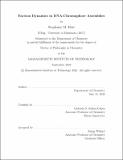Exciton Dynamics in DNA-Chromophore Assemblies
Author(s)
Hart, Stephanie M.
DownloadThesis PDF (65.42Mb)
Advisor
Schlau-Cohen, Gabriela S.
Terms of use
Metadata
Show full item recordAbstract
Excitonic systems have the potential to provide new materials for light harvesting, computing, and imaging. Such applications require control over the spatiotemporal evolution of excited states. Natural light harvesting systems achieve the required control through precise molecular placement; however, it has been challenging to emulate multi-chromophore organization in synthetic systems. Towards mimicking these nat- ural architectures, we use DNA-chromophore assemblies to generate excitonic circuits with nanometer-scale precision over chromophore placement and orientation. First, in a bioinspired light-harvesting system, we explore the role of molecular parameters in directing electronic energy. Using time-resolved spectroscopy, we show how chromophore placement within a tunable DNA scaffold can be used to independently control both electronic coupling and system-bath coupling, and furthermore identify their roles in mediating exciton transport. We then extend this framework to identify how scaffold configurations are capable of steering formation of symmetry-breaking charge transfer states, paving the way towards the design of DNA machinery with dual light-harvesting and charge separation capabilities.
Second, we examine applications of this platform for imaging. Using vibrational wavepackets, we detect a previously unknown dark state in a cyanine fluorophore and identify the associated structural mode coupling likely responsible for its formation. We then incorporate this fluorophore into a DNA double crossover tile for easy photophysical tunability by creating a strongly coupled dimer. Through a sequence- dependent mechanical force induced by the surrounding DNA, we demonstrate that distortions can be used to construct a toolkit of fluorophores visible at the single-molecule level, suggesting potential use as an imaging probe. Lastly, we use higher order DNA origami to control exciton dynamics in singlet fission sensitizers. Collec- tively, this systematic investigation and control over excitons and their dynamics with DNA structures offers design principles for solar conversion and sensing applications at the nanoscale.
Date issued
2022-09Department
Massachusetts Institute of Technology. Department of ChemistryPublisher
Massachusetts Institute of Technology